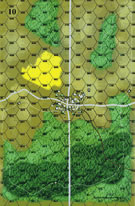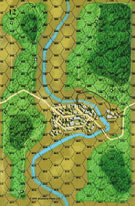|
|
|
Total |
| Side 1 |
0 |
| Draw |
0 |
| Side 2 |
0 |
|
Total |
| Side 1 |
0 |
| Draw |
0 |
| Side 2 |
0 |
|
Total |
| Side 1 |
0 |
| Draw |
0 |
| Side 2 |
0 |
|
| Overall Rating, 0 votes |
|---|
|
|
|
Scenario Rank:
of |
| Parent Game |
Edelweiss IV |
| Historicity |
Historical |
| Date |
1945-02-02 |
| Start Time |
10:00 |
| Turn Count |
24 |
| Visibility |
Day |
| Counters |
50 |
| Net Morale |
0 |
| Net Initiative |
2 |
| Maps |
2: 10, 12 |
| Layout Dimensions |
56 x 43 cm
22 x 17 in |
| Play Bounty |
212 |
| AAR Bounty |
223 |
| Total Plays |
0 |
| Total AARs |
0 |
| Duplicates |
Edel024, EdlX031 |
|
Introduction
|
|
Transferred from northern Norway be train, ship and highway, the 2nd Mountain Division arrived on the Western Front in January, 1945. taking positions in front of Colmar, they faced the tough American XX Corps and the French Foreign Legion. The division set out a thin screen to slow the American advance, but the tactics of Finland failed in Alsace. The U.S. 28th Division, following instructions to "attack without pause," shredded the German line so quickly the mountain division reported itself under attack by an armored corps.
|
|
Conclusion
|
|
After more than four years in the Arctic, the Edelweiss Division was a shadow of its former self. the outpost line resisted but could not stop the Americans, by now expert in tank-infantry interactions. The "Bloody Bucket" Division brushed aside the jägers and drove into Colmar, a fortress-city that had defied the French 1st Army since October.
|
Display Relevant AFV Rules
| AFV Rules Pertaining to this Scenario's Order of Battle |
- Vulnerable to results on the Assault Combat Chart (7.25, 7.63, ACC), and may be attacked by Anti-Tank fire (11.2, DFT). Anti-Tank fire only affects the individual unit fired upon (7.62, 11.0).
- AFV's are activated by tank leaders (3.2, 3.3, 5.42, 6.8).
They may also be activated as part of an initial activating stack, but if activated in this way would need a tank
leader in order to carry out combat movement.
- AFV's do not block Direct Fire (10.1).
- Full-strength AFV's with "armor efficiency" may make two anti-tank (AT) fire attacks per turn
(either in their action segment or during opportunity fire) if they have AT fire values of 0 or more
(11.2).
- Each unit with an AT fire value of 2 or more may fire at targets at a distance of between 100% and 150% of its
printed AT range. It does so at half its AT fire value. (11.3)
- Efficient and non-efficient AFV's may conduct two opportunity fires per turn if using direct fire
(7.44, 7.64).
Units with both Direct and AT Fire values may use either type of fire in the same turn as their opportunity fire,
but not both (7.22, 13.0).
Units which can take opportunity fire twice per turn do not have to target the same unit both times (13.0).
- Demoralized AFV's are not required to flee from units that do not have AT fire values (14.3).
- Place a Wreck marker when an AFV is eliminated in a bridge or town hex (16.3).
- AFV's do not benefit from Entrenchments (16.42).
- AFV's may Dig In (16.2).
- Closed-top AFV's: Immune to M, M1 and M2 results on Direct and Bombardment Fire Tables. Do not take step losses from Direct or Bombardment Fire. If X or #X result on Fire Table, make M morale check instead (7.25, 7.41, 7.61, BT, DFT).
- Closed-top AFV's: Provide the +1 modifier on the Assault Table when combined with infantry. (Modifier only applies to Germans in all scenarios; Soviet Guards in scenarios taking place after 1942; Polish, US and Commonwealth in scenarios taking place after 1943.) (ACC)
- Tank: all are closed-top and provide the +1 Assault bonus, when applicable
|
United States Order of Battle
| 1 Errata Item |

|
The movement allowance on the counters in Airborne is misprinted. It should be "3."
|




 EdIV038
EdIV038 




















